Effective Supply Chain Management and Design for Textile Industry
VerifiedAdded on 2023/06/03
|8
|1582
|355
Report
AI Summary
This report delves into the complexities of supply chain management (SCM) within the textile industry, highlighting key issues such as vendor selection and the challenges posed by fast fashion. The study emphasizes the importance of SCM in aligning products with customer demands and achieving goals like waste reduction and increased flexibility. The report proposes the use of the Analytic Hierarchy Process (AHP) for effective vendor selection, addressing the need for efficient supplier management in the face of rapidly changing fashion trends. Additionally, it suggests implementing a scanning-based information transmission system using RFID tags and ERP to improve communication across different departments. The conclusion underscores the significance of these solutions in adapting to the demands of fast fashion and improving overall SCM efficiency in the textile sector.
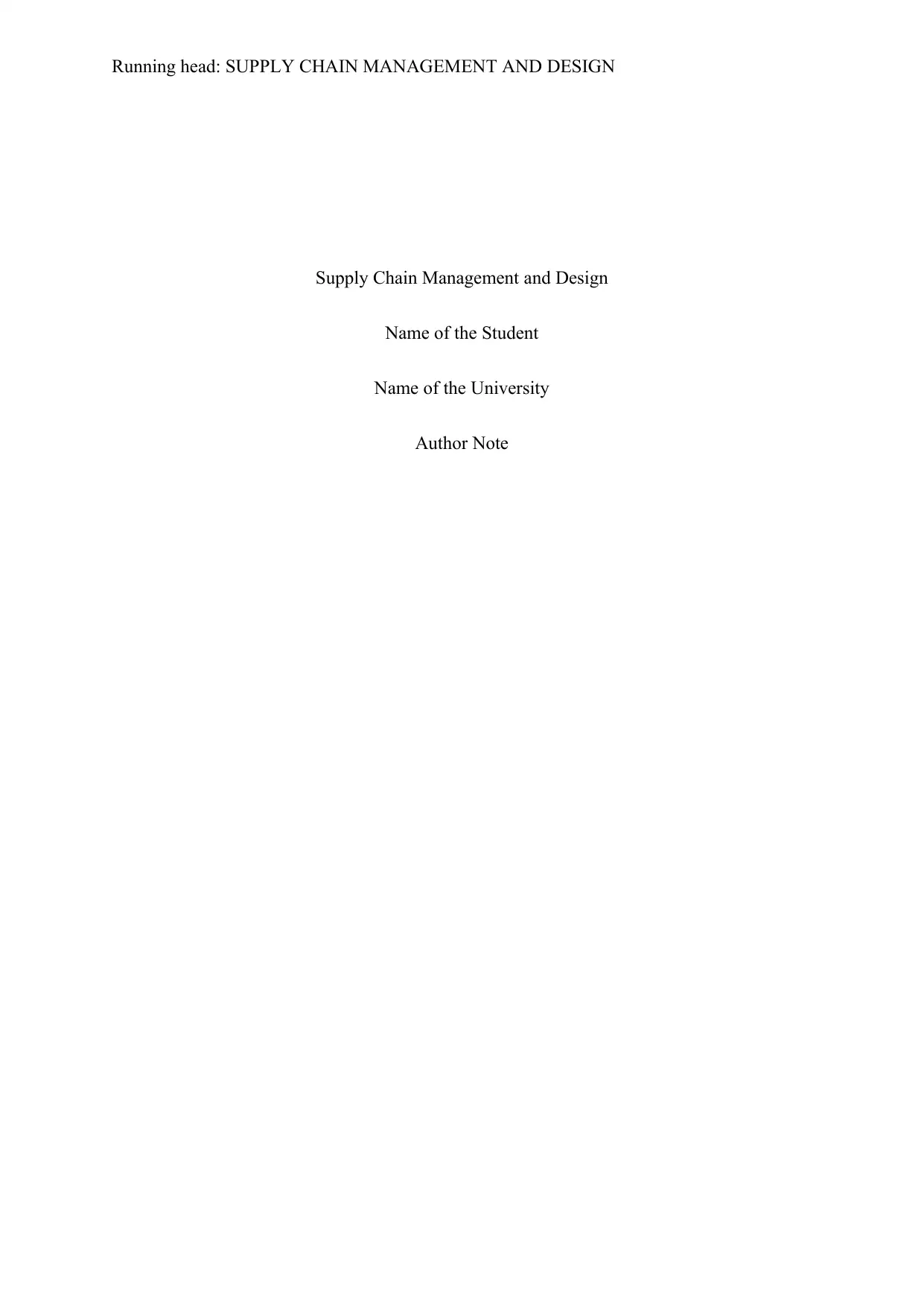
Running head: SUPPLY CHAIN MANAGEMENT AND DESIGN
Supply Chain Management and Design
Name of the Student
Name of the University
Author Note
Supply Chain Management and Design
Name of the Student
Name of the University
Author Note
Paraphrase This Document
Need a fresh take? Get an instant paraphrase of this document with our AI Paraphraser
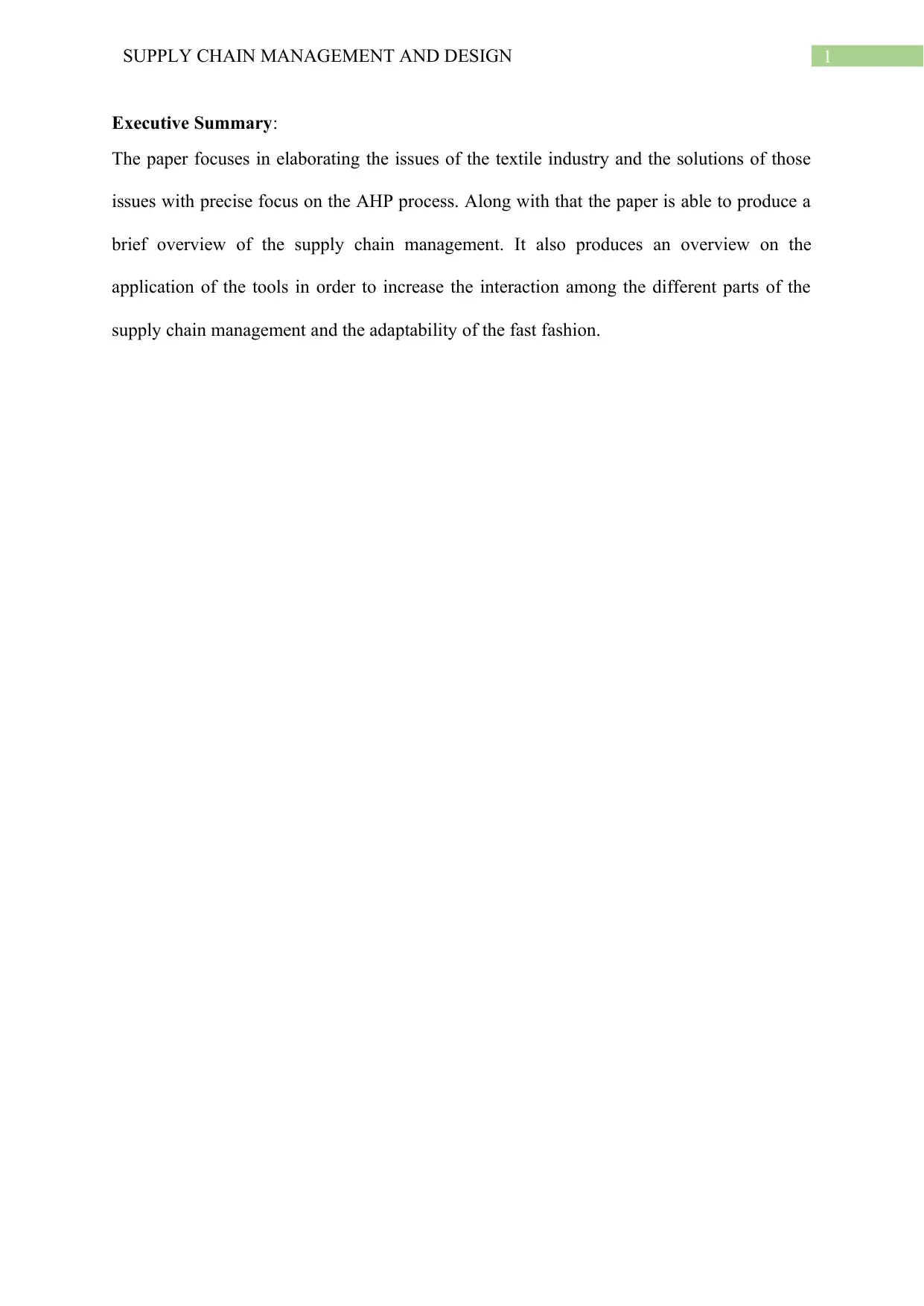
1SUPPLY CHAIN MANAGEMENT AND DESIGN
Executive Summary:
The paper focuses in elaborating the issues of the textile industry and the solutions of those
issues with precise focus on the AHP process. Along with that the paper is able to produce a
brief overview of the supply chain management. It also produces an overview on the
application of the tools in order to increase the interaction among the different parts of the
supply chain management and the adaptability of the fast fashion.
Executive Summary:
The paper focuses in elaborating the issues of the textile industry and the solutions of those
issues with precise focus on the AHP process. Along with that the paper is able to produce a
brief overview of the supply chain management. It also produces an overview on the
application of the tools in order to increase the interaction among the different parts of the
supply chain management and the adaptability of the fast fashion.
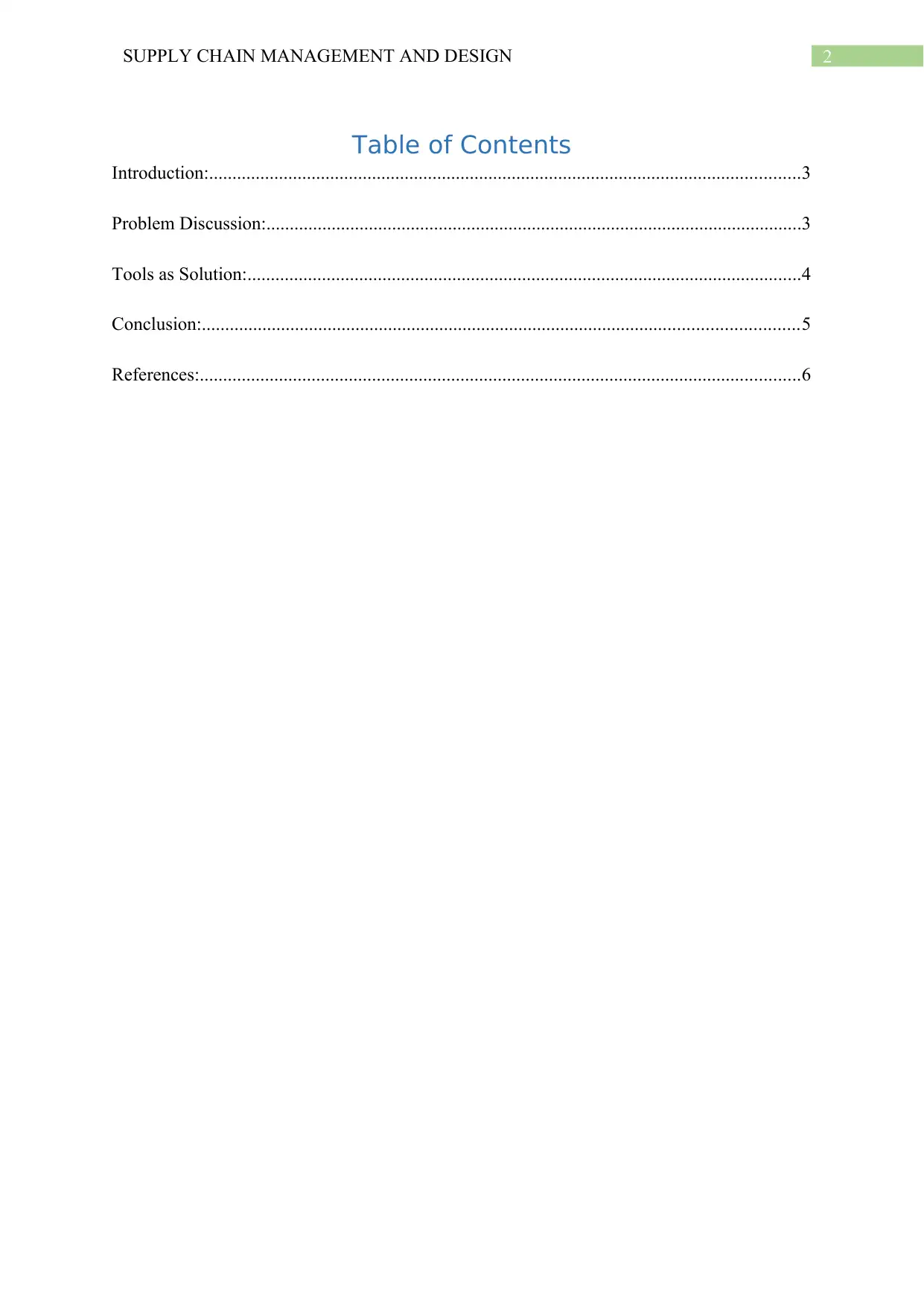
2SUPPLY CHAIN MANAGEMENT AND DESIGN
Table of Contents
Introduction:...............................................................................................................................3
Problem Discussion:...................................................................................................................3
Tools as Solution:.......................................................................................................................4
Conclusion:................................................................................................................................5
References:.................................................................................................................................6
Table of Contents
Introduction:...............................................................................................................................3
Problem Discussion:...................................................................................................................3
Tools as Solution:.......................................................................................................................4
Conclusion:................................................................................................................................5
References:.................................................................................................................................6
⊘ This is a preview!⊘
Do you want full access?
Subscribe today to unlock all pages.

Trusted by 1+ million students worldwide
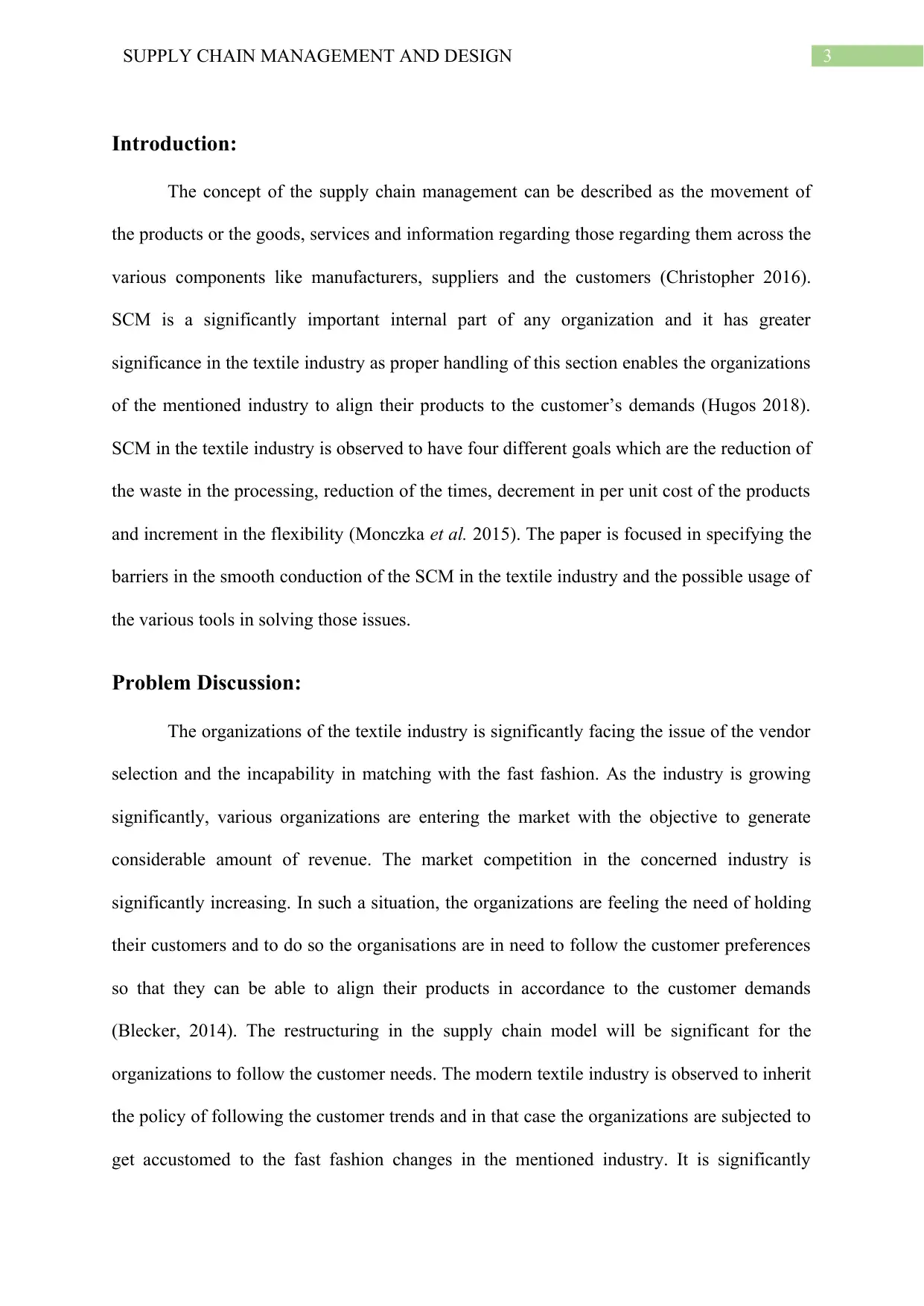
3SUPPLY CHAIN MANAGEMENT AND DESIGN
Introduction:
The concept of the supply chain management can be described as the movement of
the products or the goods, services and information regarding those regarding them across the
various components like manufacturers, suppliers and the customers (Christopher 2016).
SCM is a significantly important internal part of any organization and it has greater
significance in the textile industry as proper handling of this section enables the organizations
of the mentioned industry to align their products to the customer’s demands (Hugos 2018).
SCM in the textile industry is observed to have four different goals which are the reduction of
the waste in the processing, reduction of the times, decrement in per unit cost of the products
and increment in the flexibility (Monczka et al. 2015). The paper is focused in specifying the
barriers in the smooth conduction of the SCM in the textile industry and the possible usage of
the various tools in solving those issues.
Problem Discussion:
The organizations of the textile industry is significantly facing the issue of the vendor
selection and the incapability in matching with the fast fashion. As the industry is growing
significantly, various organizations are entering the market with the objective to generate
considerable amount of revenue. The market competition in the concerned industry is
significantly increasing. In such a situation, the organizations are feeling the need of holding
their customers and to do so the organisations are in need to follow the customer preferences
so that they can be able to align their products in accordance to the customer demands
(Blecker, 2014). The restructuring in the supply chain model will be significant for the
organizations to follow the customer needs. The modern textile industry is observed to inherit
the policy of following the customer trends and in that case the organizations are subjected to
get accustomed to the fast fashion changes in the mentioned industry. It is significantly
Introduction:
The concept of the supply chain management can be described as the movement of
the products or the goods, services and information regarding those regarding them across the
various components like manufacturers, suppliers and the customers (Christopher 2016).
SCM is a significantly important internal part of any organization and it has greater
significance in the textile industry as proper handling of this section enables the organizations
of the mentioned industry to align their products to the customer’s demands (Hugos 2018).
SCM in the textile industry is observed to have four different goals which are the reduction of
the waste in the processing, reduction of the times, decrement in per unit cost of the products
and increment in the flexibility (Monczka et al. 2015). The paper is focused in specifying the
barriers in the smooth conduction of the SCM in the textile industry and the possible usage of
the various tools in solving those issues.
Problem Discussion:
The organizations of the textile industry is significantly facing the issue of the vendor
selection and the incapability in matching with the fast fashion. As the industry is growing
significantly, various organizations are entering the market with the objective to generate
considerable amount of revenue. The market competition in the concerned industry is
significantly increasing. In such a situation, the organizations are feeling the need of holding
their customers and to do so the organisations are in need to follow the customer preferences
so that they can be able to align their products in accordance to the customer demands
(Blecker, 2014). The restructuring in the supply chain model will be significant for the
organizations to follow the customer needs. The modern textile industry is observed to inherit
the policy of following the customer trends and in that case the organizations are subjected to
get accustomed to the fast fashion changes in the mentioned industry. It is significantly
Paraphrase This Document
Need a fresh take? Get an instant paraphrase of this document with our AI Paraphraser
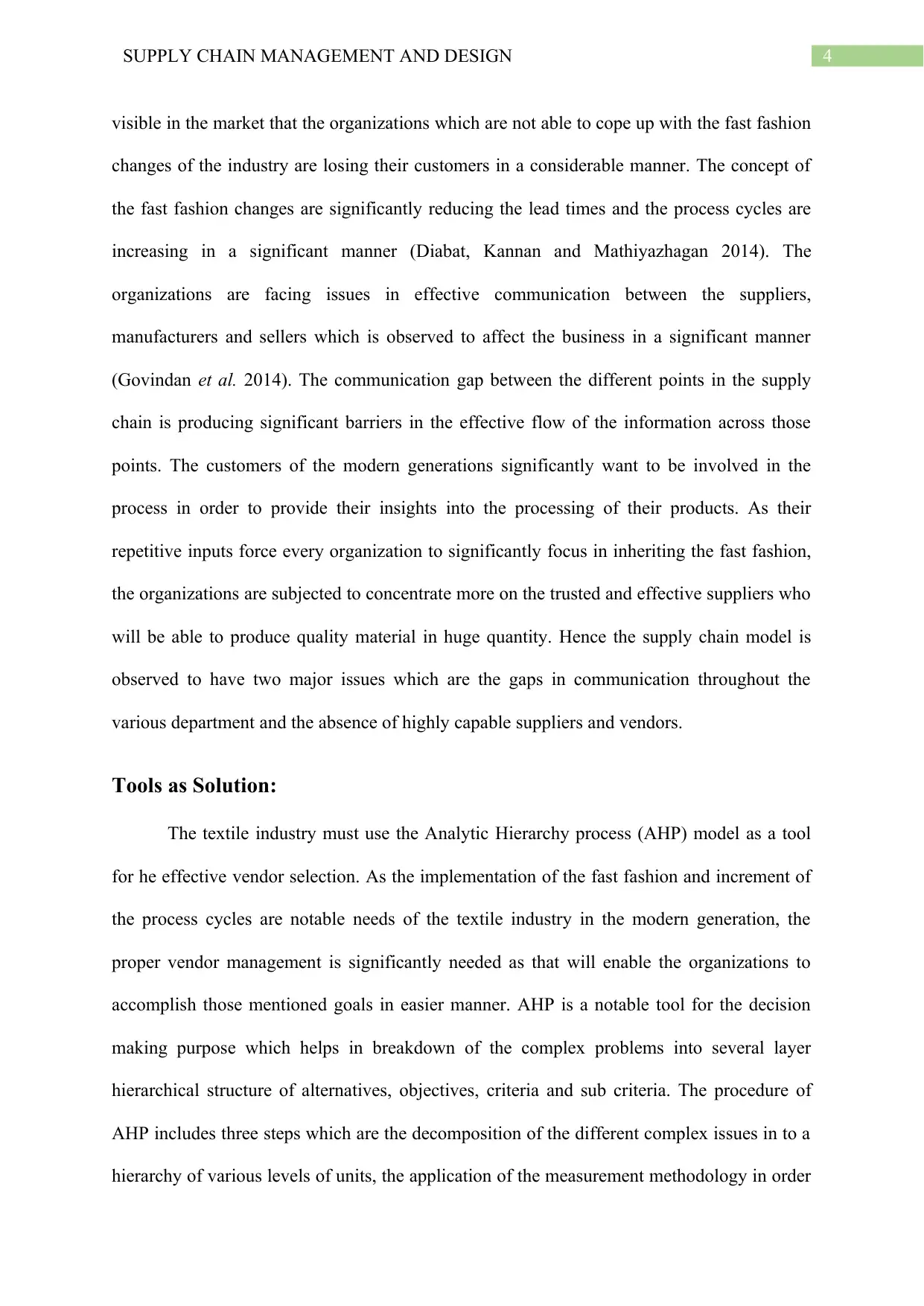
4SUPPLY CHAIN MANAGEMENT AND DESIGN
visible in the market that the organizations which are not able to cope up with the fast fashion
changes of the industry are losing their customers in a considerable manner. The concept of
the fast fashion changes are significantly reducing the lead times and the process cycles are
increasing in a significant manner (Diabat, Kannan and Mathiyazhagan 2014). The
organizations are facing issues in effective communication between the suppliers,
manufacturers and sellers which is observed to affect the business in a significant manner
(Govindan et al. 2014). The communication gap between the different points in the supply
chain is producing significant barriers in the effective flow of the information across those
points. The customers of the modern generations significantly want to be involved in the
process in order to provide their insights into the processing of their products. As their
repetitive inputs force every organization to significantly focus in inheriting the fast fashion,
the organizations are subjected to concentrate more on the trusted and effective suppliers who
will be able to produce quality material in huge quantity. Hence the supply chain model is
observed to have two major issues which are the gaps in communication throughout the
various department and the absence of highly capable suppliers and vendors.
Tools as Solution:
The textile industry must use the Analytic Hierarchy process (AHP) model as a tool
for he effective vendor selection. As the implementation of the fast fashion and increment of
the process cycles are notable needs of the textile industry in the modern generation, the
proper vendor management is significantly needed as that will enable the organizations to
accomplish those mentioned goals in easier manner. AHP is a notable tool for the decision
making purpose which helps in breakdown of the complex problems into several layer
hierarchical structure of alternatives, objectives, criteria and sub criteria. The procedure of
AHP includes three steps which are the decomposition of the different complex issues in to a
hierarchy of various levels of units, the application of the measurement methodology in order
visible in the market that the organizations which are not able to cope up with the fast fashion
changes of the industry are losing their customers in a considerable manner. The concept of
the fast fashion changes are significantly reducing the lead times and the process cycles are
increasing in a significant manner (Diabat, Kannan and Mathiyazhagan 2014). The
organizations are facing issues in effective communication between the suppliers,
manufacturers and sellers which is observed to affect the business in a significant manner
(Govindan et al. 2014). The communication gap between the different points in the supply
chain is producing significant barriers in the effective flow of the information across those
points. The customers of the modern generations significantly want to be involved in the
process in order to provide their insights into the processing of their products. As their
repetitive inputs force every organization to significantly focus in inheriting the fast fashion,
the organizations are subjected to concentrate more on the trusted and effective suppliers who
will be able to produce quality material in huge quantity. Hence the supply chain model is
observed to have two major issues which are the gaps in communication throughout the
various department and the absence of highly capable suppliers and vendors.
Tools as Solution:
The textile industry must use the Analytic Hierarchy process (AHP) model as a tool
for he effective vendor selection. As the implementation of the fast fashion and increment of
the process cycles are notable needs of the textile industry in the modern generation, the
proper vendor management is significantly needed as that will enable the organizations to
accomplish those mentioned goals in easier manner. AHP is a notable tool for the decision
making purpose which helps in breakdown of the complex problems into several layer
hierarchical structure of alternatives, objectives, criteria and sub criteria. The procedure of
AHP includes three steps which are the decomposition of the different complex issues in to a
hierarchy of various levels of units, the application of the measurement methodology in order
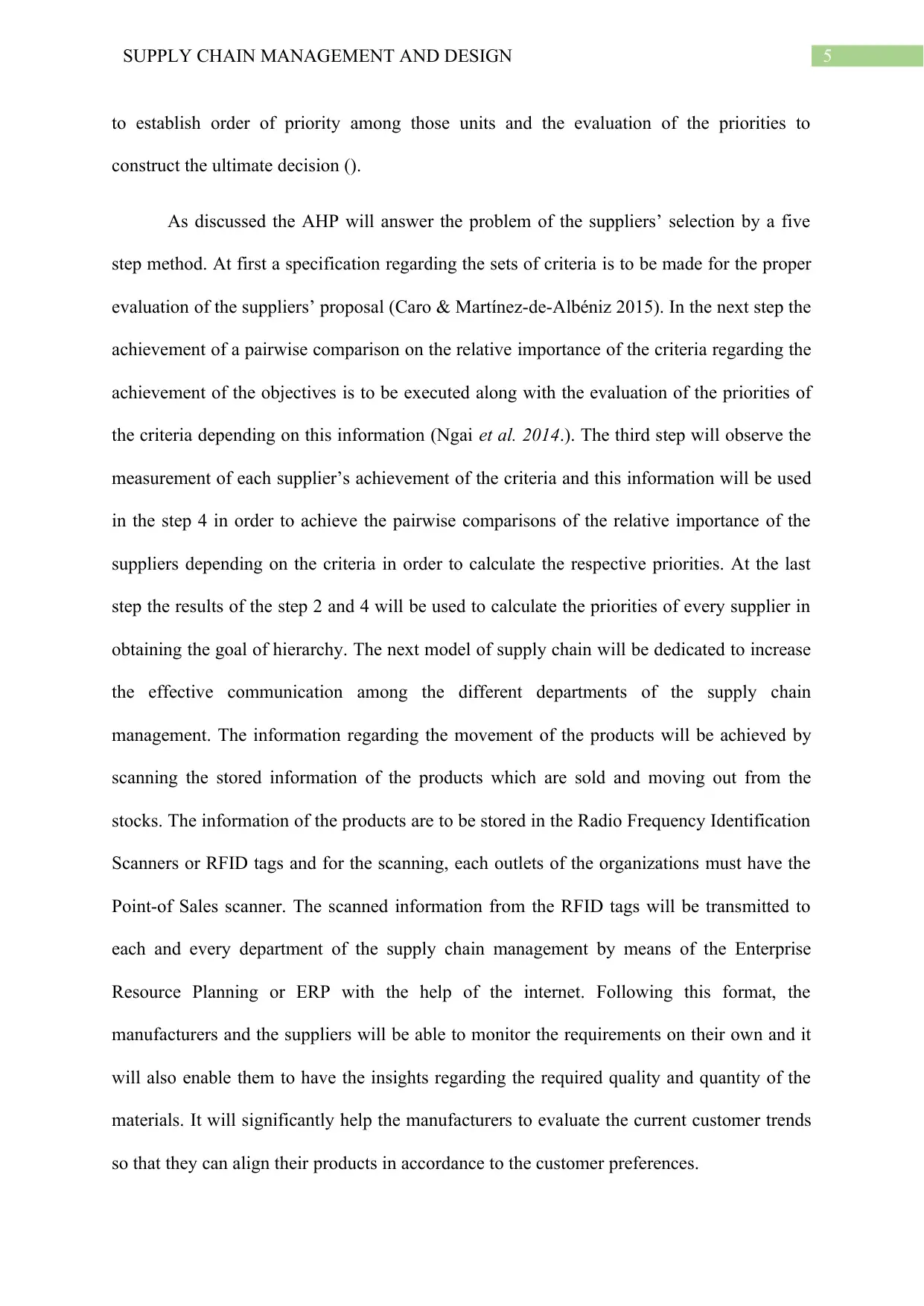
5SUPPLY CHAIN MANAGEMENT AND DESIGN
to establish order of priority among those units and the evaluation of the priorities to
construct the ultimate decision ().
As discussed the AHP will answer the problem of the suppliers’ selection by a five
step method. At first a specification regarding the sets of criteria is to be made for the proper
evaluation of the suppliers’ proposal (Caro & Martínez-de-Albéniz 2015). In the next step the
achievement of a pairwise comparison on the relative importance of the criteria regarding the
achievement of the objectives is to be executed along with the evaluation of the priorities of
the criteria depending on this information (Ngai et al. 2014.). The third step will observe the
measurement of each supplier’s achievement of the criteria and this information will be used
in the step 4 in order to achieve the pairwise comparisons of the relative importance of the
suppliers depending on the criteria in order to calculate the respective priorities. At the last
step the results of the step 2 and 4 will be used to calculate the priorities of every supplier in
obtaining the goal of hierarchy. The next model of supply chain will be dedicated to increase
the effective communication among the different departments of the supply chain
management. The information regarding the movement of the products will be achieved by
scanning the stored information of the products which are sold and moving out from the
stocks. The information of the products are to be stored in the Radio Frequency Identification
Scanners or RFID tags and for the scanning, each outlets of the organizations must have the
Point-of Sales scanner. The scanned information from the RFID tags will be transmitted to
each and every department of the supply chain management by means of the Enterprise
Resource Planning or ERP with the help of the internet. Following this format, the
manufacturers and the suppliers will be able to monitor the requirements on their own and it
will also enable them to have the insights regarding the required quality and quantity of the
materials. It will significantly help the manufacturers to evaluate the current customer trends
so that they can align their products in accordance to the customer preferences.
to establish order of priority among those units and the evaluation of the priorities to
construct the ultimate decision ().
As discussed the AHP will answer the problem of the suppliers’ selection by a five
step method. At first a specification regarding the sets of criteria is to be made for the proper
evaluation of the suppliers’ proposal (Caro & Martínez-de-Albéniz 2015). In the next step the
achievement of a pairwise comparison on the relative importance of the criteria regarding the
achievement of the objectives is to be executed along with the evaluation of the priorities of
the criteria depending on this information (Ngai et al. 2014.). The third step will observe the
measurement of each supplier’s achievement of the criteria and this information will be used
in the step 4 in order to achieve the pairwise comparisons of the relative importance of the
suppliers depending on the criteria in order to calculate the respective priorities. At the last
step the results of the step 2 and 4 will be used to calculate the priorities of every supplier in
obtaining the goal of hierarchy. The next model of supply chain will be dedicated to increase
the effective communication among the different departments of the supply chain
management. The information regarding the movement of the products will be achieved by
scanning the stored information of the products which are sold and moving out from the
stocks. The information of the products are to be stored in the Radio Frequency Identification
Scanners or RFID tags and for the scanning, each outlets of the organizations must have the
Point-of Sales scanner. The scanned information from the RFID tags will be transmitted to
each and every department of the supply chain management by means of the Enterprise
Resource Planning or ERP with the help of the internet. Following this format, the
manufacturers and the suppliers will be able to monitor the requirements on their own and it
will also enable them to have the insights regarding the required quality and quantity of the
materials. It will significantly help the manufacturers to evaluate the current customer trends
so that they can align their products in accordance to the customer preferences.
⊘ This is a preview!⊘
Do you want full access?
Subscribe today to unlock all pages.

Trusted by 1+ million students worldwide
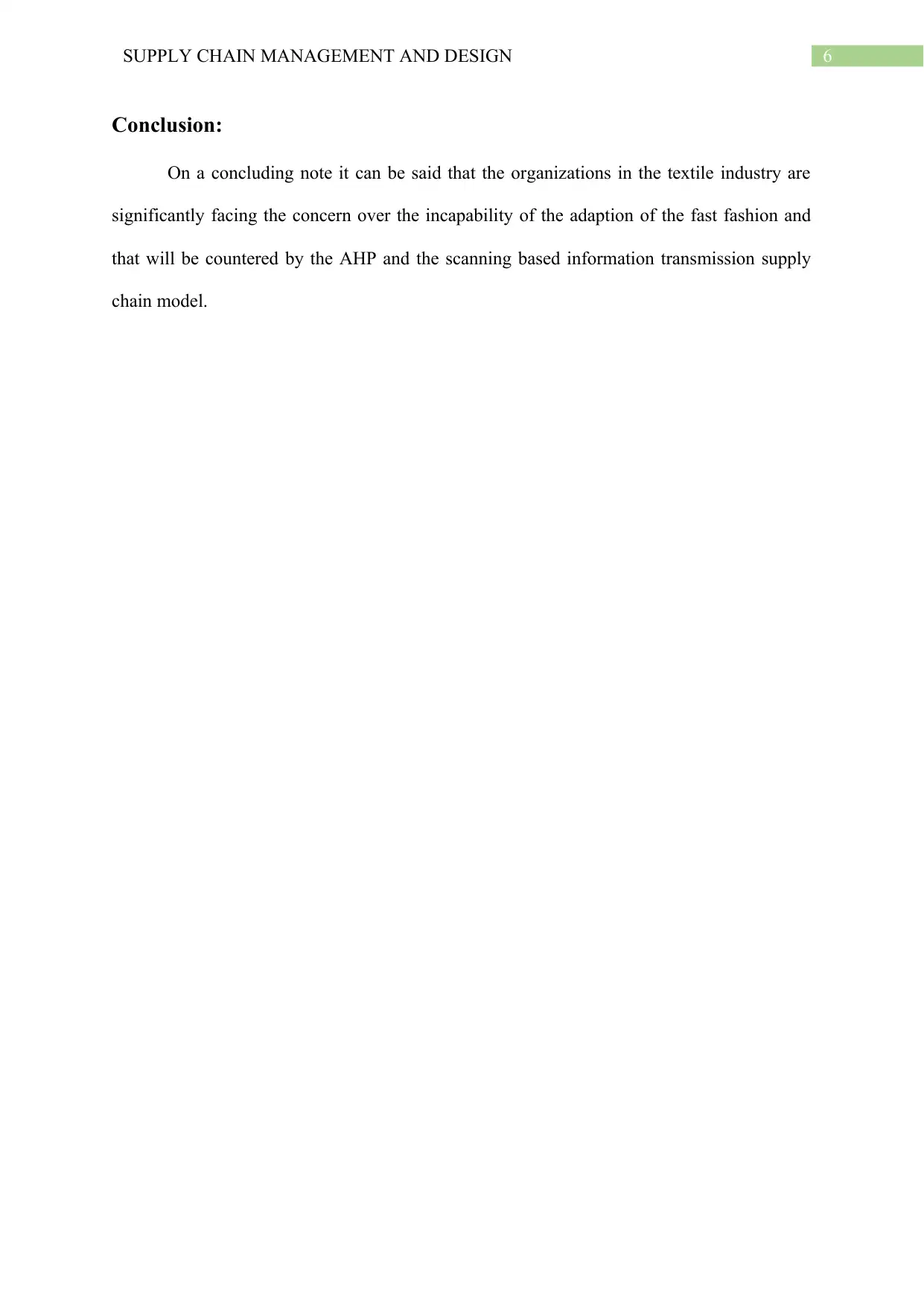
6SUPPLY CHAIN MANAGEMENT AND DESIGN
Conclusion:
On a concluding note it can be said that the organizations in the textile industry are
significantly facing the concern over the incapability of the adaption of the fast fashion and
that will be countered by the AHP and the scanning based information transmission supply
chain model.
Conclusion:
On a concluding note it can be said that the organizations in the textile industry are
significantly facing the concern over the incapability of the adaption of the fast fashion and
that will be countered by the AHP and the scanning based information transmission supply
chain model.
Paraphrase This Document
Need a fresh take? Get an instant paraphrase of this document with our AI Paraphraser
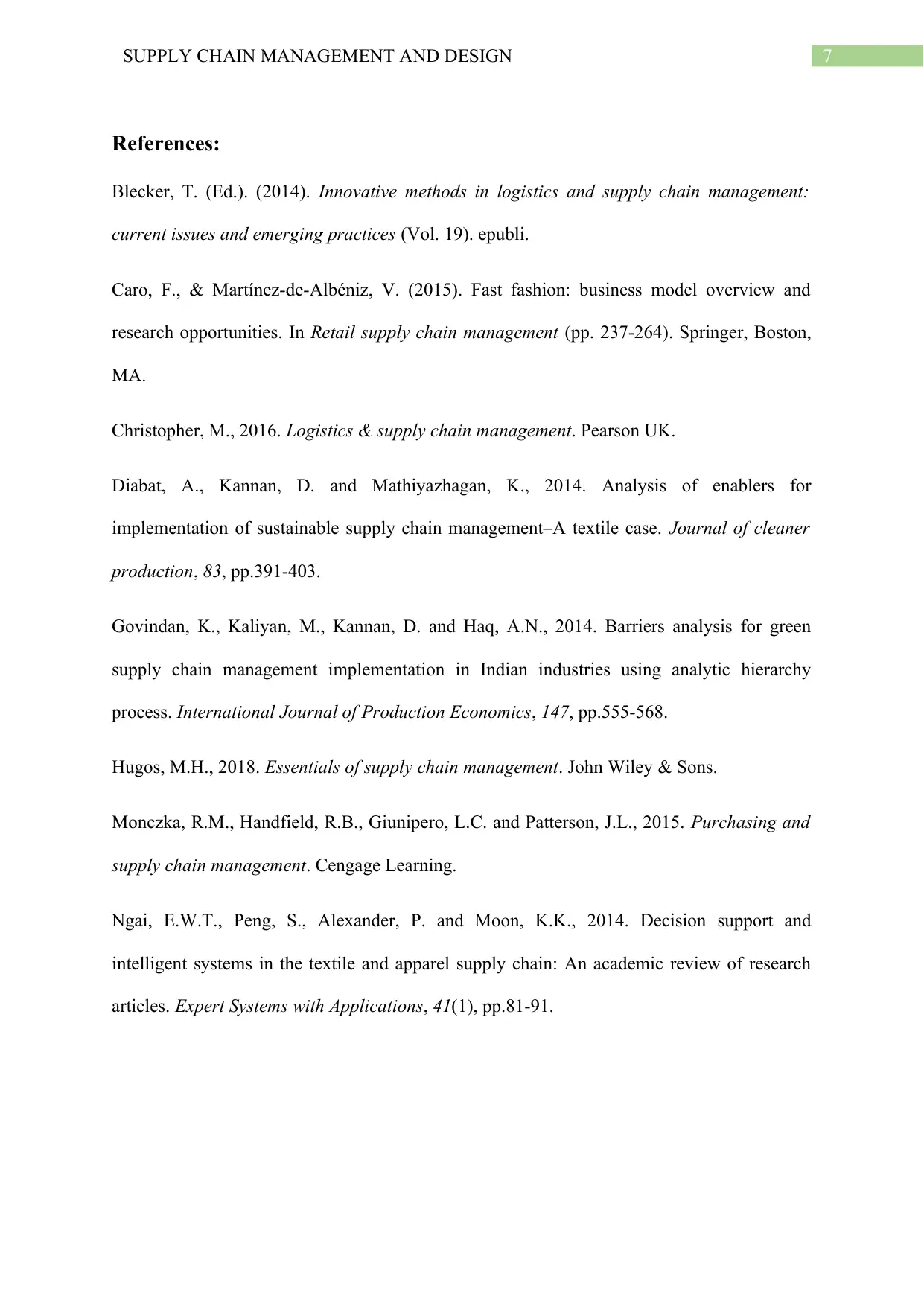
7SUPPLY CHAIN MANAGEMENT AND DESIGN
References:
Blecker, T. (Ed.). (2014). Innovative methods in logistics and supply chain management:
current issues and emerging practices (Vol. 19). epubli.
Caro, F., & Martínez-de-Albéniz, V. (2015). Fast fashion: business model overview and
research opportunities. In Retail supply chain management (pp. 237-264). Springer, Boston,
MA.
Christopher, M., 2016. Logistics & supply chain management. Pearson UK.
Diabat, A., Kannan, D. and Mathiyazhagan, K., 2014. Analysis of enablers for
implementation of sustainable supply chain management–A textile case. Journal of cleaner
production, 83, pp.391-403.
Govindan, K., Kaliyan, M., Kannan, D. and Haq, A.N., 2014. Barriers analysis for green
supply chain management implementation in Indian industries using analytic hierarchy
process. International Journal of Production Economics, 147, pp.555-568.
Hugos, M.H., 2018. Essentials of supply chain management. John Wiley & Sons.
Monczka, R.M., Handfield, R.B., Giunipero, L.C. and Patterson, J.L., 2015. Purchasing and
supply chain management. Cengage Learning.
Ngai, E.W.T., Peng, S., Alexander, P. and Moon, K.K., 2014. Decision support and
intelligent systems in the textile and apparel supply chain: An academic review of research
articles. Expert Systems with Applications, 41(1), pp.81-91.
References:
Blecker, T. (Ed.). (2014). Innovative methods in logistics and supply chain management:
current issues and emerging practices (Vol. 19). epubli.
Caro, F., & Martínez-de-Albéniz, V. (2015). Fast fashion: business model overview and
research opportunities. In Retail supply chain management (pp. 237-264). Springer, Boston,
MA.
Christopher, M., 2016. Logistics & supply chain management. Pearson UK.
Diabat, A., Kannan, D. and Mathiyazhagan, K., 2014. Analysis of enablers for
implementation of sustainable supply chain management–A textile case. Journal of cleaner
production, 83, pp.391-403.
Govindan, K., Kaliyan, M., Kannan, D. and Haq, A.N., 2014. Barriers analysis for green
supply chain management implementation in Indian industries using analytic hierarchy
process. International Journal of Production Economics, 147, pp.555-568.
Hugos, M.H., 2018. Essentials of supply chain management. John Wiley & Sons.
Monczka, R.M., Handfield, R.B., Giunipero, L.C. and Patterson, J.L., 2015. Purchasing and
supply chain management. Cengage Learning.
Ngai, E.W.T., Peng, S., Alexander, P. and Moon, K.K., 2014. Decision support and
intelligent systems in the textile and apparel supply chain: An academic review of research
articles. Expert Systems with Applications, 41(1), pp.81-91.
1 out of 8
Related Documents
Your All-in-One AI-Powered Toolkit for Academic Success.
+13062052269
info@desklib.com
Available 24*7 on WhatsApp / Email
![[object Object]](/_next/static/media/star-bottom.7253800d.svg)
Unlock your academic potential
Copyright © 2020–2025 A2Z Services. All Rights Reserved. Developed and managed by ZUCOL.




